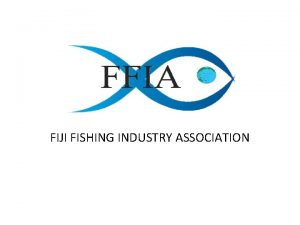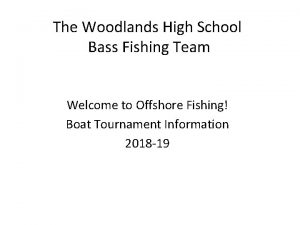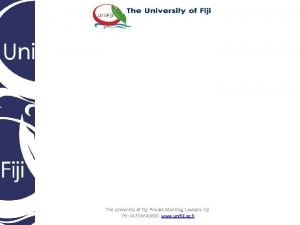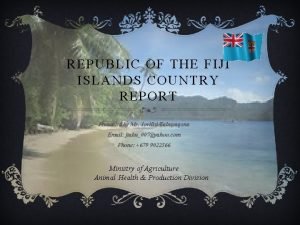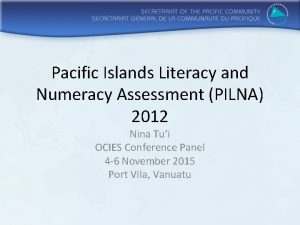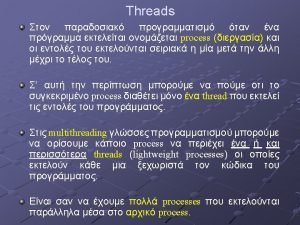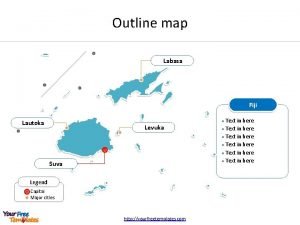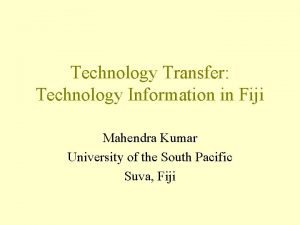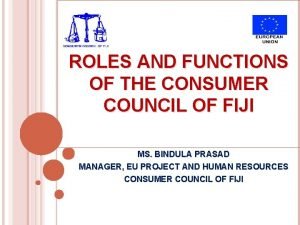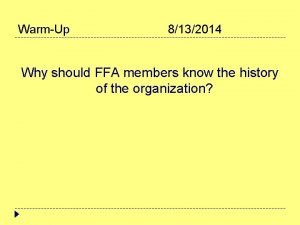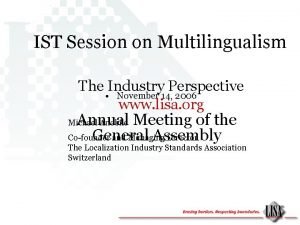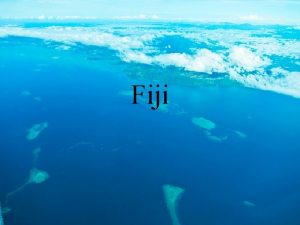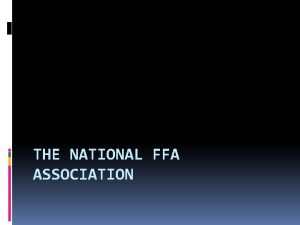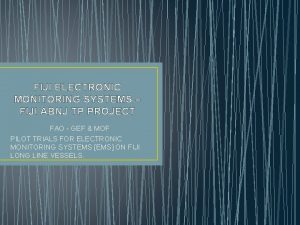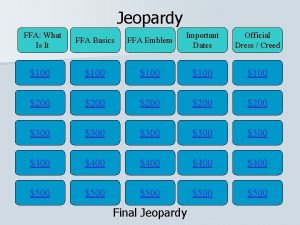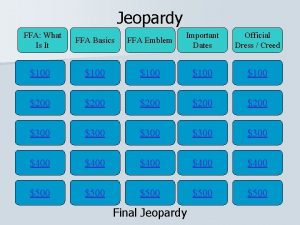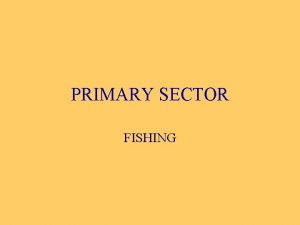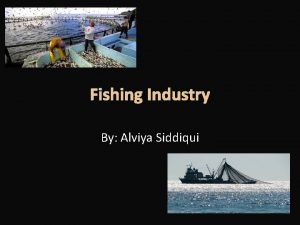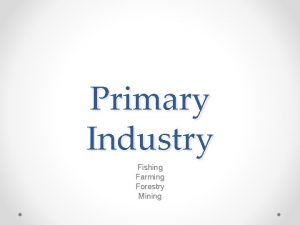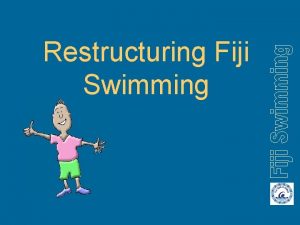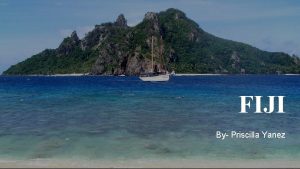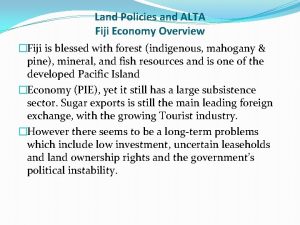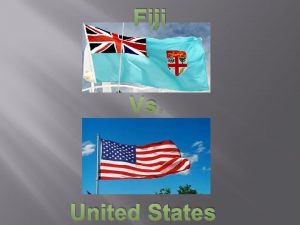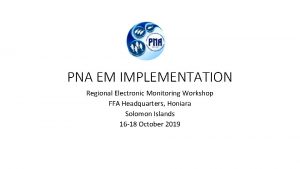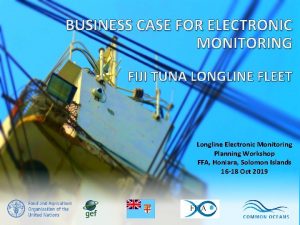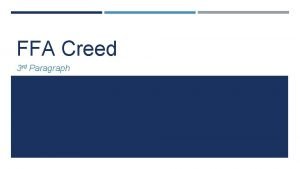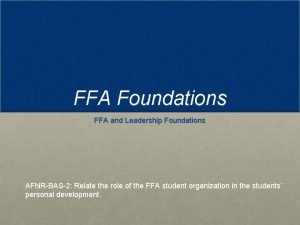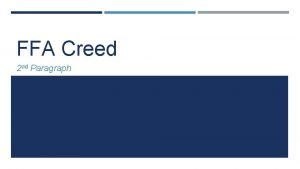FIJI FISHING INDUSTRY ASSOCIATION ELECTRONIC MONITORING WORKSHOP FFA
























- Slides: 24

FIJI FISHING INDUSTRY ASSOCIATION

ELECTRONIC MONITORING WORKSHOP FFA CONFERENCE ROOM HONIARA, SOLOMON ISLANDS 16 – 18 October 2019

FOUR YEARS OF ELECTRONIC MONITORING TRIAL IN FIJI’S SURFACE LONG LINE FLEET – WHAT NOW?

Introduction • The first phase of the largest, and most comprehensive, EM project in the Pacific has just been completed in Fiji • There are seven various EM trials currently underway within the WCPO (including Australia and New Zealand) but none have had the number of vessels or scrutiny as that has been afforded to the FAO/GEF Fiji project

• The Fiji trial, being part of a much larger Common Oceans ABNJ Programme managed by the UN FAO and implemented by Fiji Government and the FFIA • The Fiji Fishing Industry agreed to provide the vessels and the necessary "sea time" as an "in kind" contribution to the project, which represented 9. 2% of the total global co-financing of the five-year project • Concurrent with Go. F signing the FAO contract, a MOU was entered into between the Ministry of Fisheries and FFIA, amongst other things, assuring access by companies to camera footages

• This is an important distinction as the trial was always seen as having two aims: 1. to provide compliance and scientific benefits to Government; and 2. onboard management benefits to the Industry The five-year programme will formaly cease at the end of this month, October 2019

What should happen now is the subject of this presentation It is to be noted that the terminal evaluation of the Fiji trial (still in draft) states: "Pilot trials of electronic observer systems onboard tuna longline vessels successfully completed in Fiji with lessons learnt and best practices disseminated to sub-regional organisations and T-RFMOs for upscaling”

• Under the Fiji pilot trial, 50 long line vessels were fitted with cameras and an analysis group was established within the Mo. F that had undergone the relevant trainings by SATLINK • This group was tasked with reviewing 100% of the camera footage • In an in-depth report, prepared by MRAG Asia Pacific, titled “Building a Business Case for Electronic Monitoring for the Fiji long line fishing industry” (MRAG Business Case) the results of the Fiji trial were reviewed • As the title suggests, it provided options for the business case going forward • This included proposals for the joint financing of ongoing costs by Government and the Industry

• The proportionality of the costs between Government and the Industry were also discussed • None of the various options have yet to be adopted and a hiatus exists • This uncertain position is further compounded by the Mo. F currently withholding timely access to footages pending higher Government approval • The primary commercial reason for Industry involvement in the trials is negated until a decision on having access to the footages is made

• Information from Australia is that companies get access to this information on a regular basis • It is essential for Industry in moving forward with EM, that the trip footage be supplied so that they can improve on board processes and safety at sea • The WCPFC is yet to determine when and how EM will be incorporated within their MCS programmes • However, it is understood that implementation of EM by WCPFC is at least three years away

• EM does not come cheaply but if made compulsory would provide, together with physical observers, 100% observer coverage • (However, what 100% actually means and how much of the footage would need to be reviewed has to be established and the costing fully understood) • This, we understand, is to be the ultimate aim of the WCPFC • The various MRAG Business Case models built upon Fiji’s already high physical observer coverage of 32% and an effective 80% EM surveillance • The actual observer coverage required by WCPFC is currently only 5% and some member nations are not even meeting this target

• The parlous fiscal state of the surface long line fishery in the South Pacific is well known • Consequently, the Fiji domestic long line industry is not sufficiently robust enough to accept in total the additional costs needed to continue the existing EM programme • Put simply, it is cheaper to pay for 100% physical observers, than to meet the estimated costs of continuing the existing program • Whilst there are savings in cost (vice physical observers) in Australia and New Zealand, it is not so in PIC’s where labour rates are considerably cheaper. • Nevertheless, it must be accepted that the Fiji pilot project is undoubtably the best and most valuable precursor to rolling out EMS in the WCPFC • The value of at sea experience by commercial operators cannot be underestimated in determining the way forward in establishing any compulsory EM protocol

• We have quite deliberately described the FAO/GEF project as the “first phase” • This is because the preliminary work necessary for final implementation of EM within Fiji, let alone a WCPFC roll out, is not complete • Furthermore, it is not suggested that the “Fiji model” is perfect since there is still more work to be done

The positions of the FFIA are: 1. the current programme should continue until the WCPFC decides on the modus operandi of their preferred EM protocol 2. the programme should be subject to modification and change within the period to comply with likely WCPFC requirements and recommendations 3. Prompt access to camera footages to made available to owners 4. Funding be secured so that an unfair fiscal burden is not placed on the Fiji Industry

It is necessary to explain the rationale of the FFIA’s position and to do this, it is best to describe the actual “at sea” events of the past four years of EM in Fiji

(a) Acceptance of EM onboard vessels • It would be fair to say that the EM project was more welcomed by vessel owners than the crews themselves • Incidents of damage to equipment or screening of cameras occurred on some vessels more than others • Long Line vessels are comparatively small and there are limited private spaces • Cameras were seen to be an invasion of privacy by the crew whereas owners welcomed the extra surveillance both for quality management purposes but also for the control of theft or mishandling of fish • The addition of a bridge monitor allowing the Captain to view deck operations was welcomed • Co-operation of crews and owners is essential, and it is doubtful if a blunt “compulsion” regime will ever work in WCPO where voyages of two or three months are often the norm

(b) System employed • The Spanish “Satlink” technology was used • Comparisons cannot be offered between this system and those of Archipelago (Canada), Saltwater (USA) and Trident (NZ) • One FFIA member installed a Trident system but this was discontinued with the advent of the FAO/GEF project • EM continues to evolve, and all systems are constantly improving • Anecdotally there appears to be little advantage of one system against another • The relative robustness of the systems is unknown • The apparent lifespan of some of the component parts of the “Satlink” technology appears to be four or five years • Some replacements have been made within the trial period.

(c) System Support • Satlink have established an office/workshop in Suva • This is manned by 2 expatriate staffs and 1 local who have provided prompt and efficient service • Onsite support is more important than the advantages of one system against another • This is particularly so in the Pacific where maintenance and service availability is crucial • We support the continuation of Satlink, but the relative high costs have to be addressed • For example, the local charges to certify the MTU for FFA annual re-registration of VMS is FD 150, whereas the Satlink equivalent charge is USD 250 • The charge for Satlink is further compounded by a 15% withholding tax on payment for services paid overseas, which is non-recoverable • Satlink needs to establish a local company within Fiji so that clients can avoid the 15% surcharge

(d) Access to Footage. • Prompt Industry access to footage is essential and will be even more so at time of WCPFC implementation • This is no way to interfere with the compliance role of EM, which is oftened misunderstood • The synology equipment and additional Network Addtion Storage (NAS) is already held in Fiji to enable access to EMS for boat owners • The Mo. F is waiting legal advice from the Solicitor General’s Office before footage will be released • Hopefully this will be settled in soon

(e) Penalty regime where EM data is used • This has not been invoked over the period of the trial, but it is assumed it will eventually fall under the fixed penalty provisions of the Fiji OFMR (2014)

(f) Onsite project management • This has been led by the ABNJ TP national Coordinator Mr Netani Tavaga and a good cooperative relationship exists • The service charges by the Mo. F for analysis and other management will ultimately form part of the EM costs • These must be comparable to other similar projects as to the number of staff employed and open for review

(g) Supplementary information for owners • The GPS and other technology contained within the EMS allows for VMS, data transmission and live vessel tracking to be provided in addition, and separate from, the camera monitoring role • During the trial, some owners paid for the additional benefits • The use of EMS to provide this facility will definitely assist in the acceptance of EM

Conclusion • In summary, the FFIA supports the continuation of the Fiji EM pilot scheme until adoption of WCPFC EM protocols • We believe that, with WCPFC/FFA input and modifications, it could be the model adopted as the MCS EM tool for Long Line fishing • Furthermore, the model will be tested in practice prior to implementation by WCPFC • Clearly under this scenario, it is unreasonable to expect Fiji to absorb the full cost of the continuing pilot scheme

VINAKA VAKALEVU
 Fiji fishing industry association
Fiji fishing industry association Twhs bass fishing team
Twhs bass fishing team University of fiji student email
University of fiji student email Countries near fiji
Countries near fiji Pilna sample papers
Pilna sample papers Fiji flag meaning
Fiji flag meaning Companies act fiji
Companies act fiji Bottled water
Bottled water Tracey wong
Tracey wong /threads/ fiji
/threads/ fiji Fiji map outline
Fiji map outline My apa fiji
My apa fiji Mahendra kumar fiji
Mahendra kumar fiji Usp moodle
Usp moodle Functions of consumer
Functions of consumer Ubike fiji
Ubike fiji Aon insurance fiji
Aon insurance fiji Fiji institute of accountants
Fiji institute of accountants An electronic is the electronic exchange of money or scrip
An electronic is the electronic exchange of money or scrip Electronic news gathering and electronic field production
Electronic news gathering and electronic field production Jan eberly ffa facts
Jan eberly ffa facts Parts of ffa emblem
Parts of ffa emblem Localization industry standards association
Localization industry standards association Fusion industry association
Fusion industry association European biomass industry association
European biomass industry association
